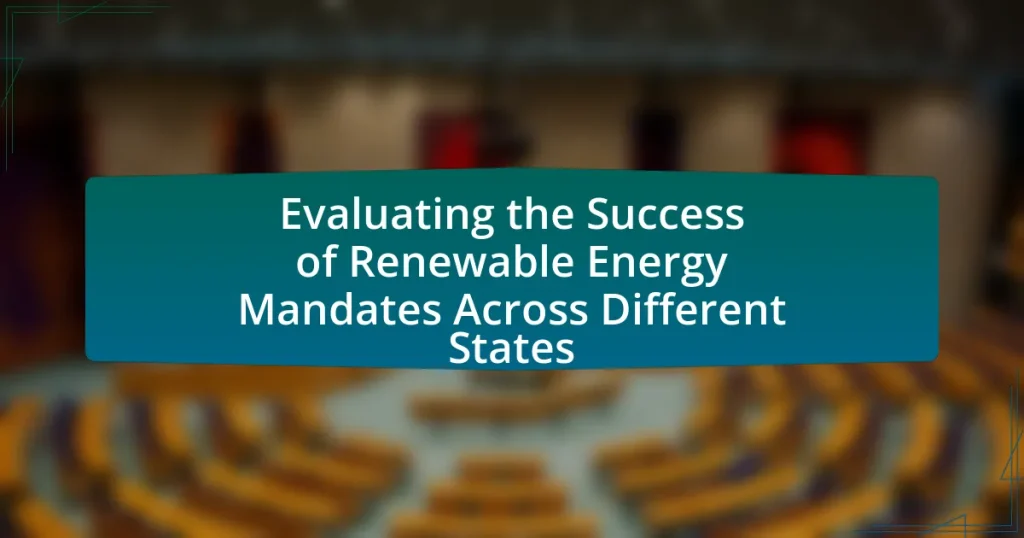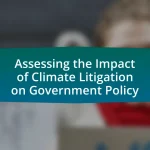Renewable energy mandates are regulations that require a specified percentage of energy production to come from renewable sources, such as solar and wind power, aimed at promoting clean energy and reducing greenhouse gas emissions. This article evaluates the effectiveness of these mandates across various U.S. states, highlighting the significant variations in implementation, the factors influencing their success, and the environmental and economic benefits they provide. Key metrics for assessing the success of these mandates include renewable energy generation rates, compliance with targets, and public adoption levels. The article also discusses challenges in evaluation, the role of public and private sectors, and best practices for enhancing the effectiveness of renewable energy initiatives.
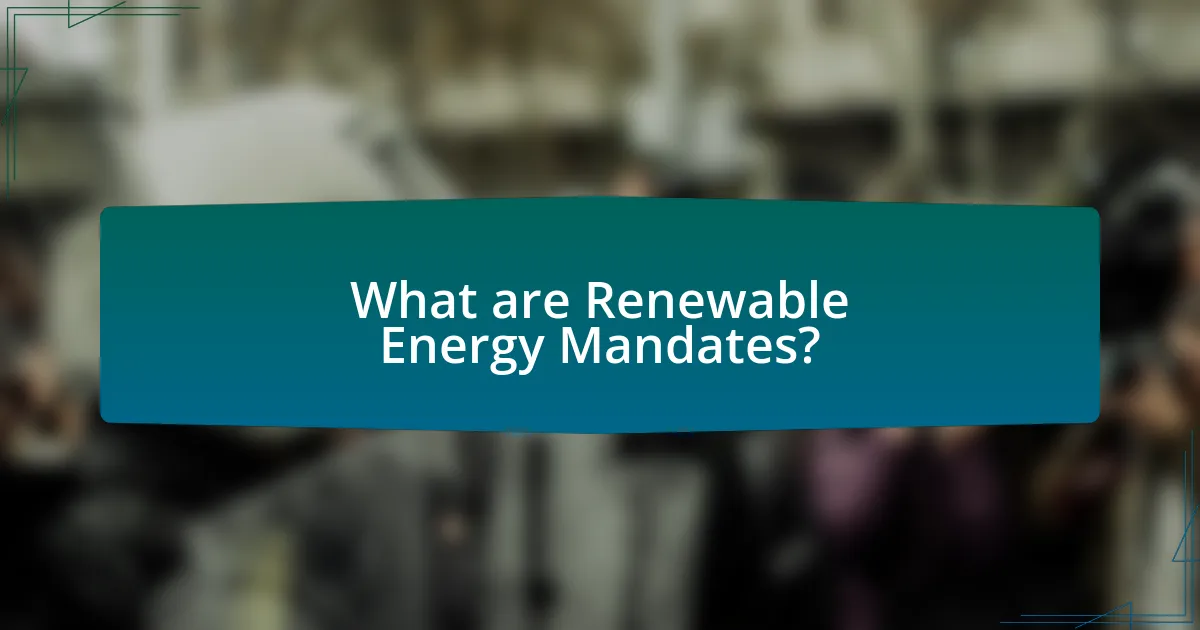
What are Renewable Energy Mandates?
Renewable energy mandates are regulations that require a certain percentage of energy production to come from renewable sources, such as solar, wind, and hydroelectric power. These mandates aim to increase the use of clean energy, reduce greenhouse gas emissions, and promote energy independence. For instance, as of 2021, 30 states in the U.S. have implemented renewable portfolio standards (RPS), which set specific targets for renewable energy generation, demonstrating the widespread adoption of such mandates.
How do Renewable Energy Mandates vary across different states?
Renewable energy mandates vary significantly across different states in the U.S., with each state implementing its own specific targets and policies. For example, California has one of the most aggressive mandates, requiring 60% of its electricity to come from renewable sources by 2030, while Hawaii aims for 100% renewable energy by 2045. In contrast, states like Texas have less stringent requirements, focusing more on market-driven renewable energy growth rather than mandated targets. Additionally, some states, such as South Dakota, have no renewable energy mandates at all, reflecting a diverse landscape of policies that influence the adoption and success of renewable energy initiatives across the country.
What factors influence the implementation of these mandates?
The implementation of renewable energy mandates is influenced by several key factors, including political will, regulatory frameworks, economic incentives, and public support. Political will is crucial as it determines the commitment of state leaders to prioritize renewable energy initiatives. Regulatory frameworks shape the legal environment, ensuring that mandates are enforceable and aligned with broader energy policies. Economic incentives, such as tax credits and subsidies, encourage investment in renewable technologies, making them more attractive to businesses and consumers. Public support plays a significant role as well; when communities advocate for renewable energy, it can lead to stronger mandates and more robust implementation efforts. These factors collectively impact how effectively renewable energy mandates are executed across different states.
How do state policies shape the effectiveness of renewable energy mandates?
State policies significantly influence the effectiveness of renewable energy mandates by establishing regulatory frameworks, financial incentives, and implementation strategies. For instance, states with aggressive renewable portfolio standards (RPS) often see higher levels of renewable energy adoption; California’s RPS requires 60% of electricity to come from renewable sources by 2030, resulting in substantial investments in solar and wind energy. Additionally, policies that provide tax credits or subsidies for renewable energy projects can enhance market competitiveness, as evidenced by New York’s Clean Energy Standard, which aims for 70% renewable energy by 2030 and has spurred growth in the solar sector. Conversely, states with weaker policies or lack of enforcement mechanisms may struggle to meet their renewable energy goals, highlighting the critical role of state-level governance in shaping outcomes.
Why are Renewable Energy Mandates important for sustainability?
Renewable energy mandates are crucial for sustainability because they drive the transition from fossil fuels to cleaner energy sources, significantly reducing greenhouse gas emissions. By establishing legally binding targets for renewable energy production, these mandates encourage investment in renewable technologies, leading to increased energy efficiency and reduced reliance on non-renewable resources. For instance, states with strong renewable energy mandates, such as California, have seen a 25% reduction in carbon emissions since implementing these policies, demonstrating their effectiveness in promoting sustainable practices.
What environmental benefits do these mandates provide?
Renewable energy mandates provide significant environmental benefits by reducing greenhouse gas emissions and promoting cleaner air quality. These mandates encourage the adoption of renewable energy sources, such as wind and solar, which produce little to no emissions compared to fossil fuels. For instance, a study by the National Renewable Energy Laboratory found that states with strong renewable energy policies have seen a reduction in carbon dioxide emissions by up to 30% over a decade. Additionally, the shift to renewables decreases reliance on non-renewable resources, leading to less habitat destruction and lower water usage in energy production.
How do they contribute to energy independence?
Renewable energy sources contribute to energy independence by reducing reliance on imported fossil fuels. By increasing the share of energy generated from wind, solar, and other renewable sources, states can produce their own energy, thereby enhancing local energy security. For instance, as of 2021, states like California and Texas have significantly increased their renewable energy capacity, leading to a decrease in oil and gas imports. This shift not only stabilizes energy prices but also mitigates the economic risks associated with global energy market fluctuations.
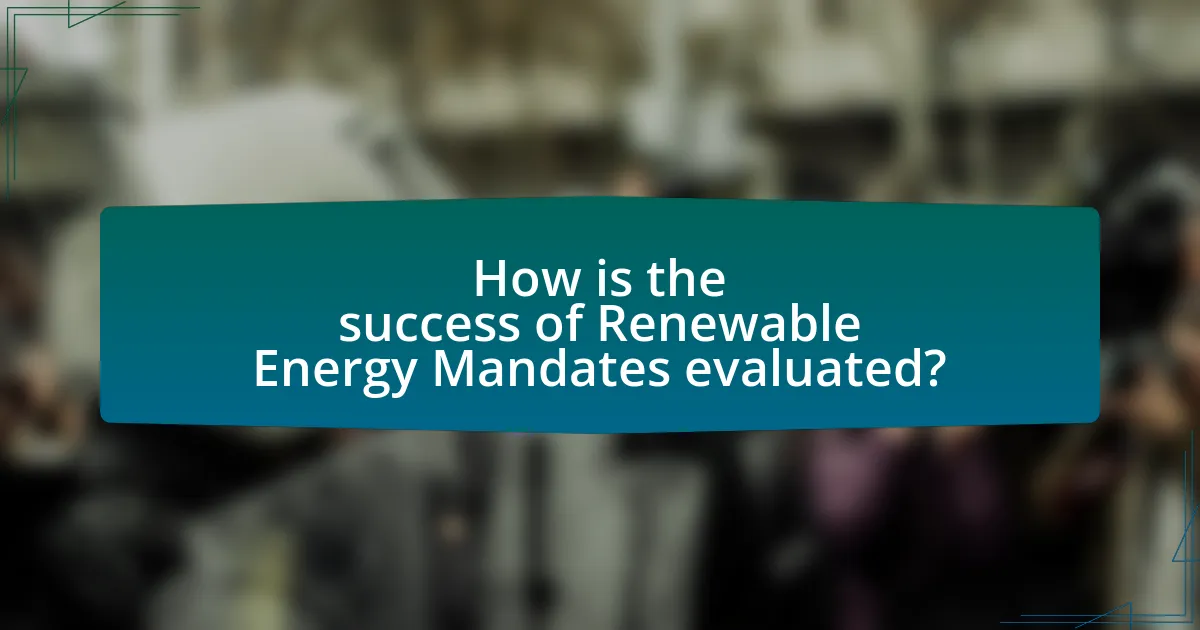
How is the success of Renewable Energy Mandates evaluated?
The success of Renewable Energy Mandates is evaluated through a combination of metrics including the percentage of energy generated from renewable sources, compliance rates with established targets, and the economic impact on job creation and investment in the renewable sector. For instance, states like California and Texas assess their progress by measuring the share of renewable energy in their overall energy mix, with California achieving over 30% from renewables in 2020, according to the California Energy Commission. Additionally, evaluations often include the analysis of greenhouse gas emissions reductions and the cost-effectiveness of renewable energy projects, providing a comprehensive view of the mandates’ effectiveness in promoting sustainable energy practices.
What metrics are used to assess the effectiveness of these mandates?
Metrics used to assess the effectiveness of renewable energy mandates include renewable energy generation percentage, greenhouse gas emissions reductions, cost-effectiveness, and compliance rates. Renewable energy generation percentage measures the share of energy produced from renewable sources compared to total energy production, providing a direct indicator of mandate success. Greenhouse gas emissions reductions quantify the decrease in emissions attributable to the mandates, reflecting their environmental impact. Cost-effectiveness evaluates the economic efficiency of implementing renewable energy technologies relative to traditional energy sources. Compliance rates indicate the extent to which states adhere to the established mandates, serving as a measure of regulatory effectiveness. These metrics collectively provide a comprehensive assessment of the mandates’ performance in promoting renewable energy adoption.
How do renewable energy generation rates factor into success evaluations?
Renewable energy generation rates are critical indicators in success evaluations of renewable energy mandates. These rates reflect the amount of energy produced from renewable sources, such as solar, wind, and hydro, compared to total energy consumption. High generation rates demonstrate effective implementation of renewable energy policies and contribute to meeting state-specific targets, such as those outlined in the Renewable Portfolio Standards (RPS). For instance, California’s RPS mandates that 60% of electricity come from renewable sources by 2030, and the state has achieved generation rates exceeding 30% from renewables, indicating progress towards its goals. Thus, evaluating these rates provides measurable evidence of the effectiveness and impact of renewable energy initiatives across different states.
What role does public adoption play in measuring success?
Public adoption is a critical metric in measuring the success of renewable energy mandates, as it directly reflects the acceptance and utilization of renewable technologies by the community. High levels of public adoption indicate that citizens are not only aware of renewable energy options but are also willing to integrate them into their daily lives, which is essential for achieving the goals set by renewable energy policies. For instance, a study by the National Renewable Energy Laboratory found that states with higher public adoption rates of solar energy saw a corresponding increase in overall renewable energy generation, demonstrating a clear link between public engagement and policy effectiveness.
What challenges are faced in evaluating the success of these mandates?
Evaluating the success of renewable energy mandates faces several challenges, including the lack of standardized metrics for assessment. Different states may employ varying criteria to measure success, such as greenhouse gas reductions, renewable energy generation, or economic impacts, leading to inconsistent evaluations. Additionally, data availability and quality can hinder accurate assessments; some states may not have comprehensive data collection systems in place, making it difficult to track progress effectively. Furthermore, external factors, such as market fluctuations and technological advancements, can influence outcomes independently of the mandates, complicating the attribution of success directly to the policies implemented.
How do economic factors impact the evaluation process?
Economic factors significantly influence the evaluation process of renewable energy mandates by affecting funding availability, investment levels, and market dynamics. For instance, states with robust economic growth can allocate more resources to renewable energy projects, leading to more comprehensive evaluations. Conversely, states facing economic downturns may prioritize budget cuts, limiting the scope and depth of evaluations. Additionally, fluctuations in energy prices can impact the perceived viability of renewable energy investments, thereby altering the criteria used in evaluations. Research indicates that states with higher economic incentives for renewable energy, such as tax credits or subsidies, tend to report more favorable evaluations, as these incentives drive greater adoption and integration of renewable technologies.
What data limitations exist in assessing renewable energy mandates?
Data limitations in assessing renewable energy mandates include incomplete datasets, inconsistent reporting standards, and lack of longitudinal studies. Incomplete datasets arise when states do not provide comprehensive information on energy production, consumption, and compliance with mandates, leading to gaps in analysis. Inconsistent reporting standards across states hinder comparability, as different metrics and definitions may be used to evaluate renewable energy performance. Additionally, the absence of longitudinal studies limits the ability to assess the long-term impacts and effectiveness of mandates, as short-term evaluations may not capture the full effects of policy implementation. These limitations can skew results and hinder informed decision-making regarding renewable energy policies.
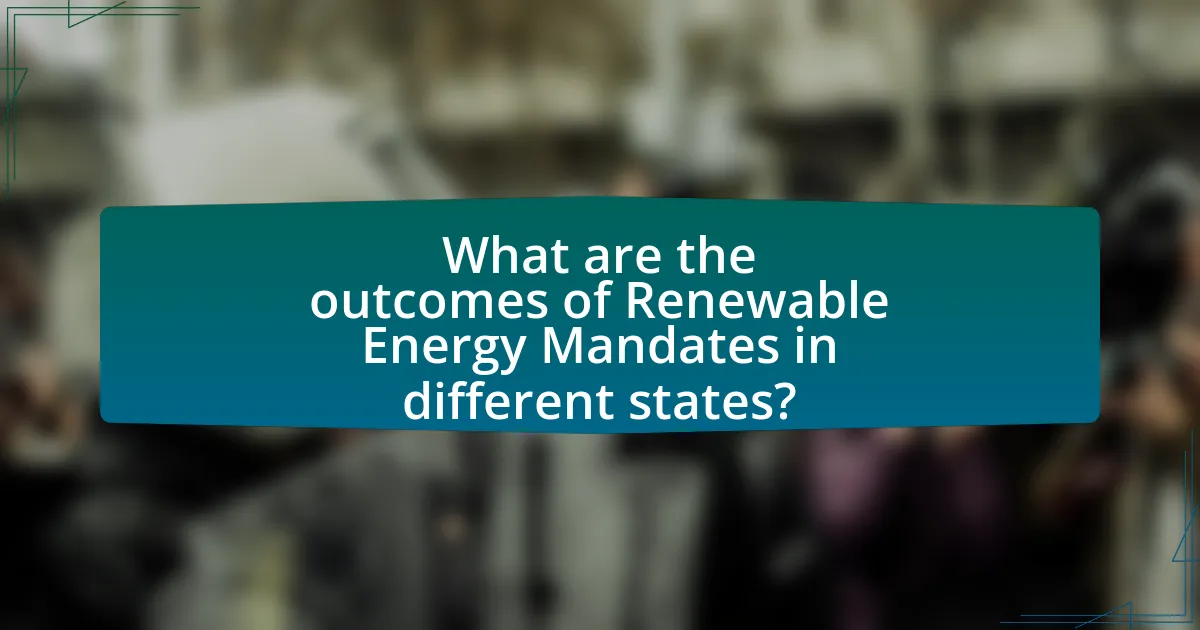
What are the outcomes of Renewable Energy Mandates in different states?
Renewable energy mandates in different states have led to increased adoption of renewable energy sources, significant reductions in greenhouse gas emissions, and economic growth in the clean energy sector. For instance, California’s Renewable Portfolio Standard requires 60% of electricity to come from renewable sources by 2030, resulting in a 25% decrease in carbon emissions from 2004 to 2019. Similarly, Massachusetts has seen a 50% increase in solar energy capacity since implementing its solar mandate in 2010, contributing to job creation in the renewable sector. Furthermore, states like Texas, which has no formal renewable energy mandate, have still achieved substantial wind energy growth due to market incentives, demonstrating that mandates can drive outcomes but are not the only pathway to success.
How have specific states succeeded or failed with their mandates?
California has succeeded with its renewable energy mandates by achieving over 50% of its electricity from renewable sources in 2020, driven by aggressive policies and investments in solar and wind energy. In contrast, Texas has faced challenges despite its significant wind energy capacity, as it has not implemented a comprehensive renewable energy mandate, leading to inconsistent growth in renewable energy adoption. These outcomes illustrate the varying effectiveness of state-level mandates in promoting renewable energy, with California’s structured approach yielding substantial results while Texas’s lack of cohesive policy has hindered its potential.
What case studies illustrate successful implementation?
California’s Renewable Portfolio Standard (RPS) serves as a prominent case study illustrating successful implementation of renewable energy mandates. Since its inception in 2002, California has mandated that utilities obtain 33% of their energy from renewable sources by 2020, which was later increased to 60% by 2030. As of 2021, the state achieved approximately 50% of its electricity from renewable sources, demonstrating significant progress. This success is supported by the California Energy Commission’s reports, which indicate that the RPS has led to substantial investments in solar and wind energy, creating jobs and reducing greenhouse gas emissions. Another notable example is Germany’s Energiewende, which has successfully transitioned the country towards renewable energy, achieving over 40% of its electricity from renewables by 2019, as reported by the Federal Ministry for Economic Affairs and Energy. These case studies exemplify effective strategies in implementing renewable energy mandates, showcasing measurable outcomes in energy generation and environmental impact.
What lessons can be learned from states with less success?
States with less success in renewable energy mandates highlight the importance of comprehensive planning and stakeholder engagement. For instance, states like Texas and South Carolina faced challenges due to insufficient infrastructure and lack of public support, which hindered the effective implementation of their renewable energy policies. Research indicates that states with clear, long-term goals and inclusive decision-making processes tend to achieve better outcomes. A study by the National Renewable Energy Laboratory found that states that engaged local communities and industry stakeholders in the planning stages saw a 30% increase in project success rates. This evidence underscores the necessity for states to prioritize collaboration and strategic foresight to enhance the effectiveness of renewable energy initiatives.
What role do public and private sectors play in the success of these mandates?
Public and private sectors are crucial for the success of renewable energy mandates, as they provide the necessary resources, expertise, and infrastructure. The public sector, through government policies and regulations, establishes the framework for renewable energy adoption, incentivizing investments and ensuring compliance with environmental standards. For instance, states like California have implemented aggressive renewable portfolio standards that require utilities to source a significant percentage of their energy from renewable sources, driving market demand.
Conversely, the private sector contributes by investing in renewable technologies and developing innovative solutions that enhance efficiency and reduce costs. Companies such as Tesla and NextEra Energy have played pivotal roles in advancing solar and wind energy technologies, demonstrating the effectiveness of private investment in achieving renewable energy goals. The collaboration between these sectors fosters a synergistic environment where public policies can be effectively implemented and private innovations can thrive, ultimately leading to the successful realization of renewable energy mandates.
How do partnerships enhance the effectiveness of renewable energy initiatives?
Partnerships enhance the effectiveness of renewable energy initiatives by facilitating resource sharing, knowledge exchange, and collaborative innovation. These collaborations often bring together diverse stakeholders, including government agencies, private companies, and non-profit organizations, which can leverage their unique strengths and expertise. For instance, a study by the National Renewable Energy Laboratory found that partnerships can lead to a 20% increase in project efficiency by combining financial resources and technical know-how. Additionally, partnerships can accelerate the deployment of renewable technologies by streamlining regulatory processes and fostering public acceptance, as evidenced by successful initiatives in states like California and New York, where multi-sector collaborations have significantly advanced renewable energy goals.
What funding mechanisms support renewable energy projects?
Funding mechanisms that support renewable energy projects include government grants, tax incentives, and private investments. Government grants, such as those provided by the U.S. Department of Energy, offer financial assistance for research and development in renewable technologies. Tax incentives, like the Investment Tax Credit (ITC) and the Production Tax Credit (PTC), significantly reduce the cost of solar and wind energy projects, encouraging investment. Additionally, private investments from venture capital and institutional investors play a crucial role in financing renewable energy initiatives, with global investments in renewable energy reaching over $300 billion in 2020, according to BloombergNEF. These mechanisms collectively enhance the financial viability of renewable energy projects, driving their growth and implementation.
What best practices can be adopted for improving Renewable Energy Mandates?
To improve Renewable Energy Mandates, states should adopt best practices such as establishing clear, measurable targets and ensuring stakeholder engagement. Clear targets provide a framework for accountability and progress tracking, while stakeholder engagement fosters collaboration among government, industry, and the public, enhancing the effectiveness of mandates. For instance, California’s Renewable Portfolio Standard mandates that 60% of electricity come from renewable sources by 2030, demonstrating the impact of specific targets on renewable energy growth. Additionally, regular assessments and adjustments based on technological advancements and market conditions can optimize the mandates, as seen in Germany’s Energiewende policy, which has evolved through continuous evaluation and adaptation.
How can states enhance stakeholder engagement in the process?
States can enhance stakeholder engagement in the process by implementing inclusive communication strategies that actively involve diverse groups in decision-making. For instance, states can organize public forums and workshops to gather input from stakeholders, ensuring that voices from various sectors, including local communities, businesses, and environmental organizations, are heard. Research indicates that states with robust stakeholder engagement frameworks, such as California’s Integrated Energy Policy Report process, have seen increased public support and collaboration, leading to more effective renewable energy policies. This approach not only fosters transparency but also builds trust, ultimately resulting in more successful implementation of renewable energy mandates.
What strategies can be implemented to overcome common challenges?
To overcome common challenges in evaluating the success of renewable energy mandates across different states, implementing a multi-faceted approach is essential. This includes establishing clear metrics for success, such as greenhouse gas emissions reductions and renewable energy adoption rates, which allows for consistent evaluation across states. Additionally, fostering collaboration among stakeholders, including government agencies, private sector players, and community organizations, enhances resource sharing and knowledge transfer, addressing barriers to implementation. Research indicates that states with collaborative frameworks, like California’s Integrated Energy Policy Report, have seen more effective outcomes in renewable energy initiatives. Furthermore, investing in public education campaigns can increase community support and participation, which is crucial for the successful adoption of renewable energy policies.
